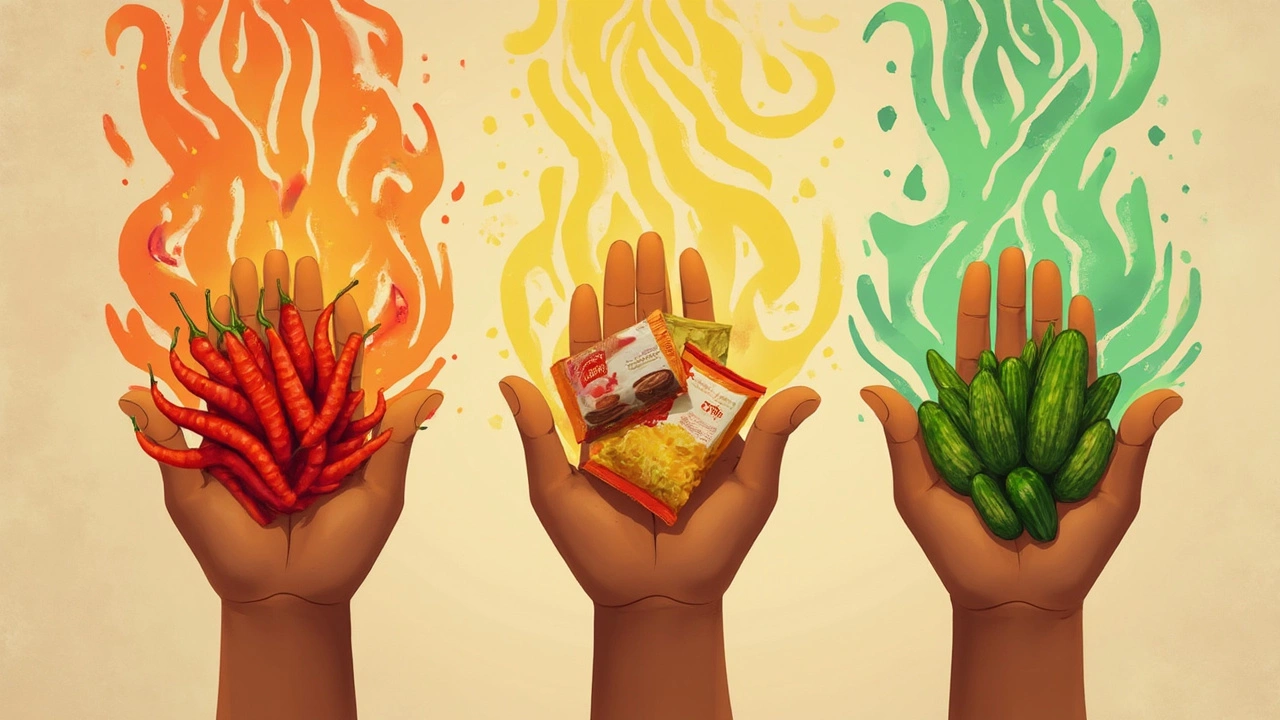
- May, 18 2025
- 0
Feeling achy, sluggish, or dealing with stubborn skin issues? According to Ayurveda, what you eat could be stirring the pot. This isn’t some trendy idea—Ayurvedic medicine has been pointing the finger at certain foods for thousands of years when it comes to chronic inflammation and nagging health problems.
It doesn’t just come down to hot chili peppers or fried stuff. Sometimes even foods you would never link to inflammation make the list if they mess with your unique dosha (body type). So if you’ve tried all the modern diets and still feel off, there’s a good chance your menu needs an Ayurvedic tune-up.
The best part? You don’t have to overhaul your life overnight. Just knowing a handful of common inflammatory foods—and small ways to switch things up—can make a solid difference. Ready to check your plate through an Ayurvedic lens? Let’s get into what you should really watch out for.
- Why Ayurveda Cares About Inflammation
- Top Inflammatory Foods According to Ayurveda
- Everyday Eating Habits That Stir Up Inflammation
- Smart Swaps and Easy Fixes
Why Ayurveda Cares About Inflammation
Here’s the thing: Ayurveda looks at health totally differently from typical Western medicine. Where modern doctors might blame just sugar or fats for inflammation, Ayurveda connects it to what’s called your dosha (your body’s unique combo of energies). According to these teachings, eating foods that disturb your dosha starts a chain reaction—think poor digestion, toxin buildup, then inflammation creeping into joints, skin, or even your mood.
This isn’t just a theory either. Ayurvedic texts like the Charaka Samhita (written around 2500 years ago) spend chapters talking about how the wrong foods can cause what’s called “ama”—sticky toxins that block your body’s channels and start fires inside (aka inflammation!).
Modern research is starting to line up with these old ideas. For example, a 2022 study from the All India Institute of Ayurveda found links between high processed food intake and chronic inflammation markers, especially in people with a Pitta or Kapha imbalance.
- Ayurveda works on root cause thinking. It believes inflammation is a warning sign your internal balance is out of whack, not just a random flare-up.
- Even so-called "healthy" foods (like yogurt or lentils) can turn inflammatory if your digestion isn’t strong or the food isn’t right for your dosha.
- Aim is to avoid what triggers inflammatory foods so your body can clear out toxins and run smoothly.
Check out how Ayurveda compares with other systems when looking at inflammation causes:
| System | Inflammation Triggers |
|---|---|
| Ayurveda | Dosha-incompatible foods, poor digestion, toxin buildup |
| Western Medicine | Processed food, sugar, trans fats, chronic stress |
| Traditional Chinese Medicine | "Dampness," poor energy flow, certain hot/spicy foods |
That’s why, in Ayurveda, paying attention to what revs up inflammation isn’t just a diet thing—it affects your energy, your sleep, and even your focus. Spotting problem foods early keeps every system running better for the long haul.
Top Inflammatory Foods According to Ayurveda
Ayurveda doesn’t just throw all foods into simple ‘good’ or ‘bad’ buckets. It actually matches what you eat to your dosha: Vata, Pitta, or Kapha. But some foods are red flags for nearly everyone when it comes to inflammation, especially if you’re eating them often or in big portions.
Here’s a breakdown of what tends to spike trouble in the body, according to Ayurveda:
- Spicy foods: Anything packed with heat—like chillies, extra-hot curries, and even a lot of garlic or onion—crank up the fire in your body. This can seriously aggravate Pitta dosha, leading to acid reflux, skin rashes, and that irritated feeling.
- Fried and oily foods: Think samosas, pakoras, heavy restaurant takeout, or street snacks. All these foods can clog your system and slow everything down, paving the way for swelling or joint aches, especially if you’re already prone to Kapha-type imbalances.
- Fermented and sour foods: Foods like vinegar-heavy pickles, aged cheeses, and some yogurts throw your gut bacteria off in Ayurvedic terms, stirring up ‘ama’—that’s sticky, undigested gunk tied to chronic problems.
- Processed and packaged foods: It’s not just a modern problem. Ayurveda warned against stale, preserved, or artificially flavored stuff long before anyone invented chips or soft drinks. These foods are hard to digest and often disrupt all three doshas, sometimes leading to fatigue and brain fog too.
- Red meat and heavy dairy: A big steak, full-fat cheeses, and cream-based desserts are tough on digestion for most people, according to Ayurvedic wisdom. Eat these too often, and you can expect to feel heavy, sluggish, and inflamed.
- Too much salt or sugar: Overdoing sweets or salty snacks pulls your system out of whack, leading to water retention, moodiness, and inflammation over time.
Here’s something to keep in mind: your own dosha might react more strongly to certain foods. For example, a Vata type might get totally thrown off by cold, dry snacks, while a Pitta does worse with chilies and tomatoes. But across the board, if you cut down these known troublemakers, you’re giving your body a better shot at staying cool and calm inside.

Everyday Eating Habits That Stir Up Inflammation
It’s not just what you eat, but how you eat that can make inflammation worse. Ayurveda pays close attention to daily habits, because sometimes, even the right foods at the wrong time can mess up your system.
One big culprit is eating late at night. Your digestion isn’t at its best after sunset, and Ayurveda says that heavy dinners or late-night snacks just sit in your gut, leading to what they call "ama"—that means toxins and sluggishness. If you’ve ever woken up with a food hangover after a midnight pizza run, you know what this feels like.
Multitasking while eating is another hidden trigger. Scrolling your phone or working through lunch distracts your mind, and Ayurveda believes your body can’t properly process food unless you’re mentally present. This often leads to overeating or reaching for foods that are quick and processed, which almost always means more inflammation.
- Chugging drinks or having lots of cold stuff with meals? Ayurveda isn’t a fan. Iced drinks can dampen your digestive fire (called Agni), making it harder to break down food. Weak digestion equals more chances for that "ama" buildup.
- Skipping meals or eating irregularly throws your digestion off track. Your body likes a routine, and eating at random times makes it harder for your gut to keep up. Ayurveda recommends sticking to two or three solid meals a day, spaced out with time for digestion in between.
- Processed, packaged foods are probably the worst, but it’s the sneaky daily habits—like snacking every hour or always grabbing something on the go—that add up fast. Most of this stuff is loaded with sugar, salt, and weird oils that raise inflammation quickly.
Check out how common habits stack up when it comes to inflammation risk, based on surveys and studies of people following Ayurvedic diets:
| Habit | Inflammation Level (Scale 1-5) | Notes |
|---|---|---|
| Eating late dinners | 5 | Most strongly linked to gut issues in Ayurveda |
| Cold drinks with meals | 4 | Slows digestion and causes bloating |
| Processed snack foods daily | 5 | Biggest spike in inflammatory markers |
| Eating while distracted | 3 | Encourages overeating and poor food choices |
| Irregular meal times | 4 | Reported by many to trigger digestive flare-ups |
It’s wild how little habits make such a big difference. You don’t have to overhaul everything at once. Try eating your biggest meal at lunch, keep dinner light and early, ditch the ice-filled drinks, and focus on your food when you eat. These simple changes can help keep those inflammation triggers at bay, and your gut will thank you.
Smart Swaps and Easy Fixes
Staring at a plate of foods you love and being told they're not great for you can be rough. But Ayurveda doesn’t demand you throw everything out and eat like a monk. You just need smarter choices—swaps you’ll actually enjoy, and small fixes that make a real difference for your body.
- Ayurveda teaches that ditching processed snacks and deep-fried foods is a major step. Instead, reach for roasted chickpeas or spiced nuts, which deliver that crunchy hit without the inflammation trigger from industrial oils.
- If you’re a fan of spicy curries or pickles, try using milder warming spices like coriander, cumin, and turmeric. Turmeric especially gets a thumbs up in Ayurveda for fighting inflammation thanks to its active ingredient, curcumin. Studies even show turmeric can significantly lower inflammation markers in the body.
- Dairy can be tough on many people, but swapping regular milk and heavy cheeses for fresh, homemade paneer or unsweetened almond milk is an easy fix. Homemade ghee (clarified butter) beats out commercial butter by a mile because it’s more digestible and less likely to upset your dosha.
- Wheat-heavy diets can aggravate inflammation, especially processed white flour. Try switching to whole grains like basmati rice, amaranth, or millet, which are all easier on digestion in Ayurveda.
Making these swaps doesn’t mean losing flavor or eating boring food. With the right herbs and preparation, your meals can actually feel more satisfying and leave you feeling lighter.
| Inflammatory Food | Ayurvedic Swap | Benefit |
|---|---|---|
| Refined Sugar | Jaggery, Honey (raw, in moderation) | Less spike in blood sugar, gentler on digestion |
| Commercial Dairy | Fresh Paneer, Almond Milk, Ghee | Better digestibility, fewer allergy triggers |
| Processed Snacks | Roasted Seeds, Spiced Nuts | Healthy fats, less inflammation |
| White Flour | Basmati Rice, Amaranth, Millet | Slower digestion, more nutrients |
| Hot Peppers | Coriander, Turmeric, Cumin | Warming, not irritating to gut |
One last tip: how you eat matters just as much as what you eat. Ayurveda suggests eating meals at regular times, avoiding late-night snacking, and chewing thoroughly. These steps give your digestive system a break and keep inflammation from flaring up.
Nikhil Verma
I'm a dedicated physician with a passion for exploring the intricacies of medicine, focusing on the unique healthcare challenges in India. I spend much of my spare time writing articles aimed at improving public understanding of health issues. Balancing my clinical practice and writing allows me to reach a wider audience, sharing insights and fostering a deeper appreciation for medical advancements. I derive immense satisfaction from both treating patients and engaging with readers through my writing.